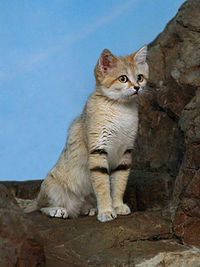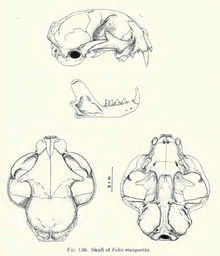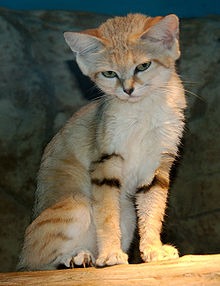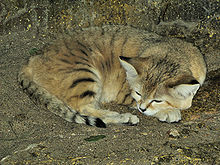- Sand cat
-
Sand cat[1] 
Conservation status Scientific classification Kingdom: Animalia Phylum: Chordata Class: Mammalia Order: Carnivora Family: Felidae Genus: Felis Species: F. margarita Binomial name Felis margarita
Loche, 1858
Geographic range The sand cat (Felis margarita), also referred to as the "sand dune cat", is a small wild cat distributed over African and Asian deserts. (The name "desert cat" is reserved for Felis silvestris lybica, the African wildcat.) The Sand cat lives in arid areas that are too hot and dry even for the African Wildcat: the Sahara, the Arabian Desert, and the deserts of Iran and Pakistan.
Victor Loche was the first European to describe the sand cat for science (in 1858). He named the species Felis margarita after Jean Auguste Margueritte, the leader of the expedition during which he had encountered the animal.
Contents
Physical characteristics
The sand cat is a relatively small, stocky cat with short legs, a long tail, and large, pointed ears. They range from 39 to 57 centimetres (15 to 22 in) in length, plus a 23 to 31 centimetres (9.1 to 12 in) tail, and weigh from 1.4 to 3.4 kilograms (3.1 to 7.5 lb).[3] The head is conspicuously broad, and the ears are so widely spaced that they can be flattened horizontally, or even pointed down to aid in hunting.
The color of the fur is a pale sandy yellow over most of the body, with pallid bars which are sometimes hardly visible, and is white on the chin and underside. Generally the bars are more visible in the African subspecies. There are black bands on the legs and tail, and reddish lines running across the cheeks from the outer corners of the eyes. In winter, the coat can be very thick, with the hairs reaching up to 2 inches (5.1 cm) in length. The eyes are large and greenish yellow in color, while the nose is black.[3]
Unusually among Asian cats, the sand cat has long hairs growing between its toes. These create a cushion of fur over the foot pads, helping to insulate them while moving over hot sand. The claws on the hind feet are small and blunt; combined with the fur over the foot pads, this helps to make the animal's tracks obscure and difficult to follow.[3]
The mucosa of their eyelids is a striking black. Accompanying the large ears, the auditory bullae are also unusually large, giving the cat an enhanced sense of hearing, probably helping it to pick up vibrations in the sand. Similar adaptations are found in other desert animals, such as the fennec fox.
Habitat
As their name implies, sand cats live only in areas of dry, sandy desert. They prefer flat or undulating terrain with sparse vegetation, avoiding bare sand dunes, where there is relatively little food. They can survive in temperatures ranging from −5 °C (23 °F) to 52 °C (126 °F), retreating into burrows during extreme conditions. Although they will drink when water is available, they are able to survive for months on the water in their food.[3]
Behavior
Sand cats live solitary lives outside of the mating season. They inhabit burrows, typically using either abandoned fox or porcupine burrows, or enlarging those dug by gerbils or other rodents. The completed burrow is generally straight, with a single entrance, and reaching up to 3 metres (9.8 ft) in length. The sand cat comes out after dusk to hunt rodents, lizards, birds, and insects, although their diet may consist mostly of rodents.[3]
They "skulk" close to the ground and will use any available cover to protect themselves. Using their large ears they listen for prey, digging rapidly when they hear it underground. Since the Sand cat obtains all the water it needs from eating its prey, it mostly stays far away from watering points where other predators may harm it.
Sand cats congregate only for mating, so counting them is a difficult task. It seems however that their numbers have been declining in the Arabian desert following a decrease in their prey. They have been observed to travel from 5 to 10 kilometres (3.1 to 6.2 mi) per night in search of prey, but, unlike most other cats, do not defend their territories, and may even "take turns" over burrows.
Threats to the Sand cat include humans, wolves, snakes, and raptors.[4] They are generally docile, and unafraid of humans.
Sand cats communicate using scent and claw marks on objects in their range, and by urine spraying, although they do not leave their feces in exposed locations as many other felids do. They make vocalizations similar to domestic cats, but also make loud, high-pitched barking sounds, especially when seeking a mate.[3]
Reproduction and life cycle
Oestrus in sand cats lasts from five to six days, and is accompanied by calling and increased scent marking. An average litter of three kittens is born after 59 to 66 days, typically around April or May, although, in some areas, sand cats may give birth to two litters per year. The kittens weigh 39 to 80 grams (1.4 to 2.8 oz) at birth, with spotted pale yellow or reddish fur. They grow relatively rapidly, reaching three quarters of the adult size within five months of birth. Sand cats are fully independent by the end of their first year, and reach sexual maturity not long after.[5] Of the 228 sand cats born in zoos globally to the year 2007 only 61% lived to day 30 of birth primarily from maternal neglect of first time mothers.[6]
Little is known about the Sand cat's life expectancy in the wild, but it can live up to 13 years in captivity.[citation needed]
Conservation
Hunting this cat is prohibited in Algeria, Iran, Israel, Kazakhstan, Mauritania, Niger, Pakistan and Tunisia. No legal protection is offered by Egypt, Mali, Morocco, Oman, Saudi Arabia, or United Arab Emirates.[4]
Captive Sand cats are highly sensitive to respiratory diseases and infection of the upper respiratory tract is the main cause of death in adults. The most common disease is infectious rhinotracheitis. With the sand cat being very susceptible to respiratory infections they have to be kept in very arid enclosures where humidity and temperature do not fluctuate. [6]
As of January 20, 2010, there are 26 sand cats in captivity in the United States.[7] In May 2010, the Al Ain Wildlife Park & Resort (AWPR) announced the first-ever birth of two Sand cat kittens following an in vitro fertilization and embryo transfer procedure at its facilities.[8]
The extirpation of the sand cat from Israel – along with the fact that the cat is threatened throughout its range – led the Jerusalem Zoo to begin a reintroduction project for the species. An acclimatization enclosure was built, using money from the Zoo's Prof. Shulov Fund for the Study of Animals in Captivity, at Kibbutz Lotan's Bird Reserve in the Arava Desert. Following construction of the enclosure, the first individuals were transferred for acclimatization, and shortly afterwards were released into the wild. The tracking of these cats after their release was conducted by the Creative Ecology staff at Kibbutz Lotan, and by Israel Nature and National Parks Protection Authority (INNPPA) rangers. The reintroduction programme was deemed unsuccessful, as the animals did not survive. [9]
Subspecies
There are six subspecies of the Sand cat:
- Felis margarita margarita, North Africa, from Algeria to Arabia
- Felis margarita airensis, Niger
- Felis margarita harrisoni, Arabian Peninsula
- Felis margarita meinertzhageni, Sahara
- Felis margarita thinobia, Caspian Sea area (Iran, Turkmenistan)
- Felis margarita scheffeli, Pakistan
F. m. thinobia is sometimes regarded as a separate species; F. m. scheffeli is listed by CITES as endangered, although IUCN only lists it as near threatened as of 2001.
References
- ^ Wozencraft, W. Christopher (16 November 2005). "Order Carnivora (pp. 532-628)". In Wilson, Don E., and Reeder, DeeAnn M., eds. Mammal Species of the World: A Taxonomic and Geographic Reference (3rd ed.). Baltimore: Johns Hopkins University Press, 2 vols. (2142 pp.). pp. 536. ISBN 978-0-8018-8221-0. OCLC 62265494. http://www.bucknell.edu/msw3.
- ^ Mallon, D.P., Sliwa, A. & Strauss, M. (2008). Felis margarita. In: IUCN 2008. IUCN Red List of Threatened Species. Downloaded on 18 January 2009.
- ^ a b c d e f Sunquist, Mel; Sunquist, Fiona (2002). Wild cats of the World. Chicago: University of Chicago Press. pp. 67–74. ISBN 0-226-77999-8.
- ^ a b Sand Cat (Felis margarita). lioncrusher.com
- ^ Mellen, J.D. (1993). "A comparative analysis of scent marking, social and reproductive behavior in 20 species of small cats (Felis)". Am. Zool. 33: 151–166. doi:10.1093/icb/33.2.151.
- ^ a b Sausman, Karen (2007). "Sand cat a true desert species". International Zoo Yearbook 35: 78–81.
- ^ [1][dead link]
- ^ Sand cat pair at Al Ain Wildlife Park and Resort. Khaleejtimes.com. Retrieved on 2011-09-27.
- ^ Jerusalem Biblical Zoo – Re-introduction – Sand cats. Jerusalemzoo.org.il. Retrieved on 2011-09-27.
External links
External identifiers for Felis margarita BioLib 1941 EOL 328670 GBIF 13808250 uBio NameBank 965899 Also found in: Wikispecies Categories:- IUCN Red List near threatened species
- Felis
- Animals described in 1858
- Mammals of Africa
- Mammals of Pakistan
- Mammals of Southwest Asia
- Fauna of Central Asia
- Fauna of the Sahara
- Carnivorans of Africa
Wikimedia Foundation. 2010.





